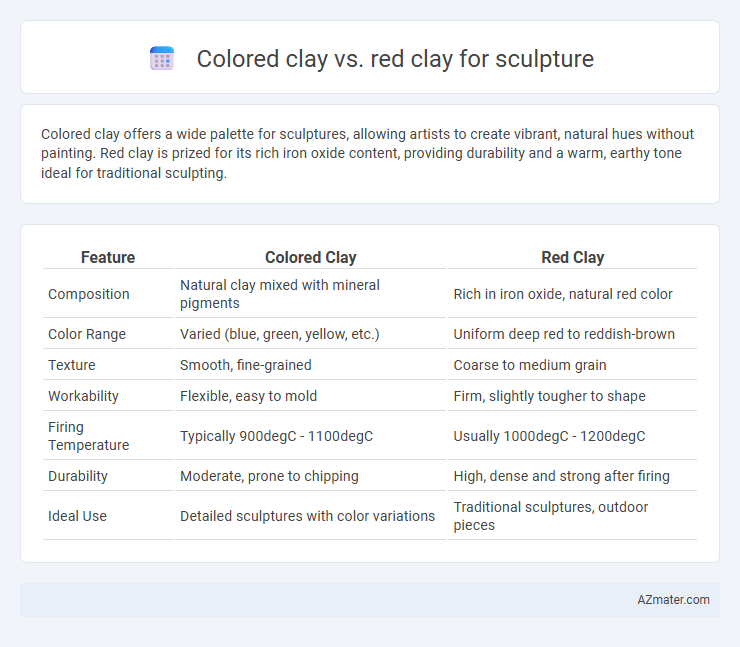Colored clay offers a wide palette for sculptures, allowing artists to create vibrant, natural hues without painting. Red clay is prized for its rich iron oxide content, providing durability and a warm, earthy tone ideal for traditional sculpting.
Table of Comparison
| Feature | Colored Clay | Red Clay |
|---|---|---|
| Composition | Natural clay mixed with mineral pigments | Rich in iron oxide, natural red color |
| Color Range | Varied (blue, green, yellow, etc.) | Uniform deep red to reddish-brown |
| Texture | Smooth, fine-grained | Coarse to medium grain |
| Workability | Flexible, easy to mold | Firm, slightly tougher to shape |
| Firing Temperature | Typically 900degC - 1100degC | Usually 1000degC - 1200degC |
| Durability | Moderate, prone to chipping | High, dense and strong after firing |
| Ideal Use | Detailed sculptures with color variations | Traditional sculptures, outdoor pieces |
Understanding Colored Clay and Red Clay
Colored clay, enriched with natural mineral pigments like iron oxide, offers artists vibrant hues without the need for surface painting, enhancing the visual appeal and texture of sculptures. Red clay, predominantly composed of iron oxide, provides durability and a warm, earthy tone ideal for traditional and contemporary sculptural works. Both clays vary in plasticity and firing temperature, influencing the final strength and finish of the sculpture.
Composition and Properties Comparison
Colored clay typically contains higher amounts of pigments and a more varied mineral composition, providing a wider color range and enhanced visual appeal for sculptures. Red clay is predominantly rich in iron oxide, giving it its characteristic reddish hue and contributing to a denser, more durable structure with superior plasticity for modeling fine details. Both clays differ in their firing temperatures, with red clay often requiring higher temperatures to achieve optimal hardness, while colored clay can vary significantly depending on its specific mineral additives.
Aesthetic Appeal and Color Variety
Colored clay offers a broader aesthetic appeal with its naturally vibrant hues ranging from blues and greens to purples, allowing sculptors to create visually striking pieces without additional painting. Red clay, prized for its rich, earthy tones and warm reddish-brown color, provides a classic and timeless look that enhances the texture and detail of sculptures. The inherent color variety in colored clay expands artistic possibilities, while red clay maintains a traditional, rustic charm favored in both contemporary and historical artworks.
Workability and Texture Differences
Colored clay offers greater workability due to its finer particle size and balanced moisture retention, making it ideal for detailed sculpting and smooth finishes. Red clay tends to be coarser with a higher iron content, resulting in a denser texture and a slightly grainier feel that can add rustic character but may challenge intricate carving. The choice between colored and red clay depends on the desired texture precision, with colored clays favoring refinement and red clays enhancing earthy, robust sculptures.
Firing Temperatures and Compatibility
Colored clay, often infused with various mineral pigments, typically requires firing temperatures ranging from 1,800degF to 2,200degF, suitable for stoneware and porcelain sculptures. Red clay, rich in iron oxide, usually fires well between 1,700degF and 2,100degF, ideal for earthenware sculptures but may show color changes depending on kiln atmosphere and firing duration. Compatibility in mixed-media sculptures depends on matching these firing ranges to prevent cracking or warping, with colored clays offering more versatility in temperature tolerance compared to some red clays.
Durability and Finished Strength
Colored clay typically offers enhanced durability due to added minerals and pigments that improve its resistance to cracking and weathering, making it ideal for detailed sculptural work. Red clay, often rich in iron oxide, provides a strong, dense finish but can be more prone to brittleness and surface chipping under prolonged exposure or stress. Sculptors seeking maximum finished strength may prefer colored clay formulations with reinforced additives, whereas red clay remains favored for traditional, natural aesthetics despite its lower structural resilience.
Cost and Availability in the Market
Colored clay generally incurs higher costs due to the additives and pigments used to achieve vibrant hues, making it less budget-friendly than red clay, which is naturally abundant and widely sourced. Red clay is more readily available in most markets because it is a common, naturally occurring material with minimal processing requirements, whereas colored clay may require specialized suppliers. Artists seeking economical and easily accessible materials typically prefer red clay, while those prioritizing variety in color often invest more in colored clay despite limited availability.
Suitability for Detailing and Fine Work
Colored clay offers enhanced visual appeal without compromising the ability to achieve intricate detailing, making it suitable for fine sculptural work. Red clay, known for its natural plasticity and firm texture, allows artists to carve precise lines and delicate features with ease. Both clays support detailed sculpting, but red clay's consistent workability often makes it preferred for highly detailed and fine artistic creations.
Popular Uses in Contemporary Sculpture
Colored clay offers a versatile palette preferred in contemporary sculpture for detailed, vibrant works that emphasize color and texture without the need for additional painting. Red clay, known for its rich iron content and earthy tones, remains popular in traditional and rustic sculptures, especially in figurative and architectural elements. Artists often choose colored clay for modern mixed-media pieces, while red clay is favored in large-scale or outdoor sculptures due to its durability and natural aesthetic.
Choosing the Right Clay for Your Project
Colored clay offers a vibrant palette that enhances detailed sculptures with ease, while red clay provides a traditional, robust texture ideal for rustic, earthy designs. Selecting the right clay depends on your project's requirements for color retention, drying time, and firing temperature, as colored clay is often ready-to-use without extra finishing. For durability and sculptural strength, red clay is preferred in high-temperature kiln firings, making it suitable for outdoor or functional art pieces.

Infographic: Colored clay vs Red clay for Sculpture
 azmater.com
azmater.com